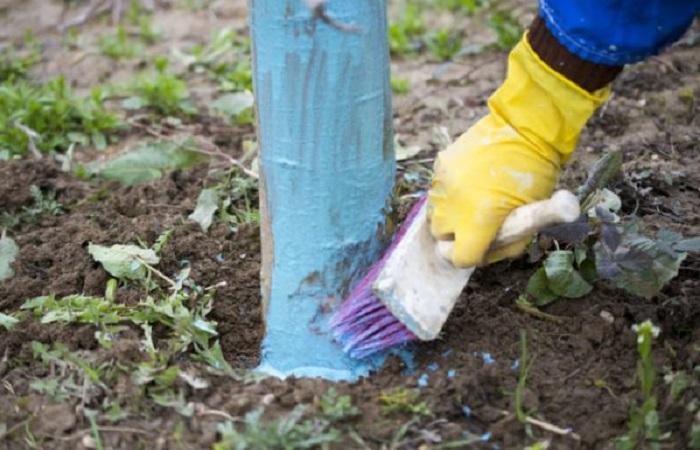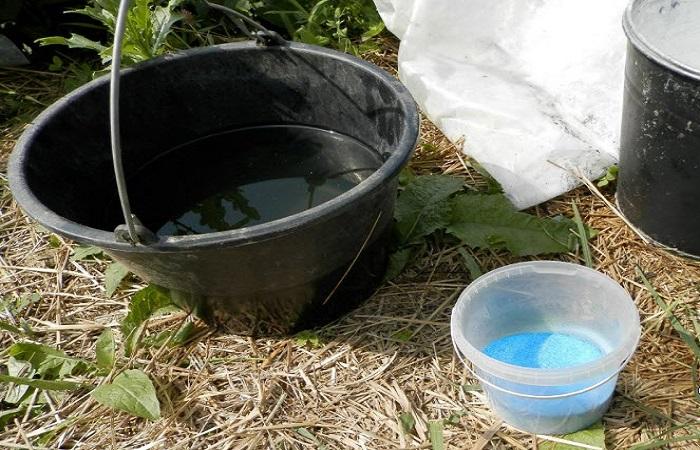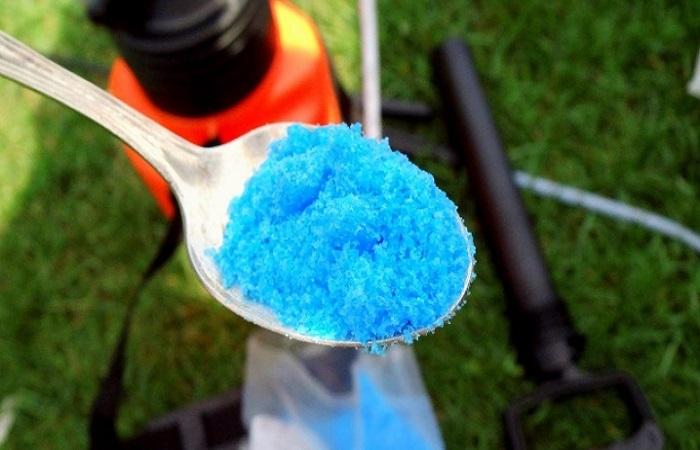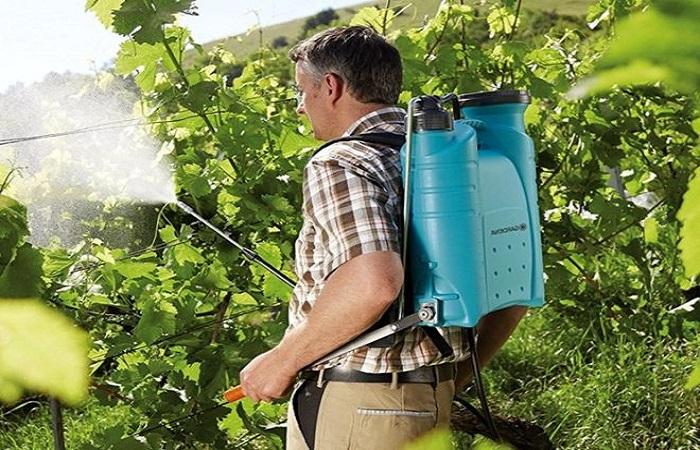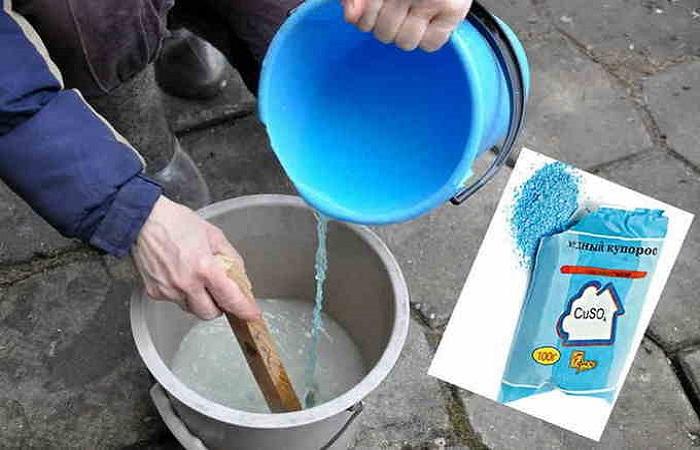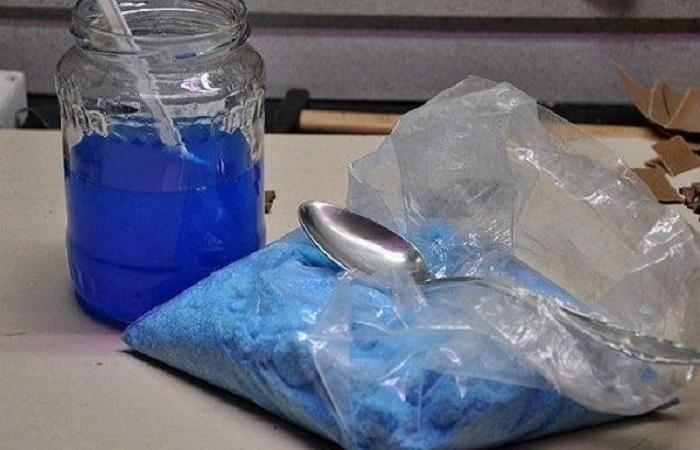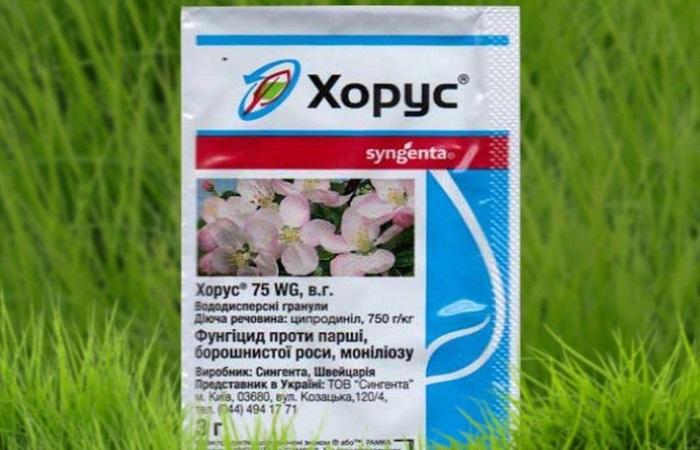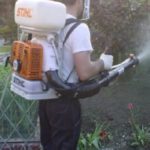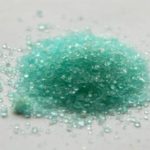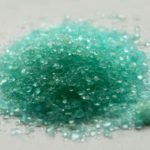Copper sulfate as a fungicide and fertilizer is widely used in gardening. This remedy is well known to gardeners and vegetable growers. The use of copper sulfate in gardening gives results in the form of good plant development and increased productivity. Let's consider when and why to use it, how to dilute the solution, in what dosage for different agricultural practices. What vitriol is compatible with, rules for storing it, similar preparations.
What is copper sulfate, principle of action
This is a copper salt of sulfuric acid, crystals of a beautiful bright blue color. They have no taste or smell. They dissolve well in heated water and are hygroscopic.
Vitriol is used in gardening as a fungicidal agent and copper fertilizer. The effect of the drug is determined by the content of copper ions, in the first case - their destructive effect on fungi, in the second - the need of plants for this element. In both cases, the effect of copper strengthens the immunity of plants, they become more resistant to diseases.
The element takes part in the formation of enzymes responsible for the metabolism of carbohydrates and nitrogen, which ultimately has a positive effect on the quality of fruits: root vegetables acquire a sweeter taste, grains of cereals and oilseeds contain more fat, protein, sugars and acids, potatoes become starchy .
When and what is it used for?
The branches and trunks of shrubs and trees, and grapevines are treated with vitriol in the spring, while they are dormant, or in the fall, when the leaves have already fallen off. It is important that there are no leaves on the plants and that the buds remain unopened, because during spring and autumn treatments a concentrated solution is used, which leaves burns on the leaves.
The purpose of using copper sulfate is as follows: to disinfect the bark on branches and trunks from fungi, to destroy pests under it and to prevent infection or the emergence of pests and their reproduction.
During the season, sulfate is used to feed plants with copper. The deficiency of this element is observed especially strongly on peat and sandy soils, less so on fertile ones, for example, on chernozems.
Copper sulfate is also used as an antiseptic, which is used to treat wooden structures to prevent the development of mold on the walls of cellars, greenhouses and other household structures. The frequency of treatment is once every six months, the solution is applied with a brush or from a spray bottle. For better adhesion and enhanced fungicidal effect, the substance is mixed with lime.
How to dilute copper sulfate
Depending on the purpose, the concentration of the drug will be different. General preparation rules: only a non-metallic container is suitable for stirring the solution; you can take a plastic, glass or ceramic one. Do not take cold water, it is best to warm it up to 50˚C. In cold conditions, dissolution takes longer, and the crystals quickly settle to the bottom. Dissolving and preparing the solution takes longer.
For feeding
Once a season you need to fertilize the soil with copper-containing fertilizers. Apply vitriol at the rate of 1 g per 1 sq. m. Since it is difficult to evenly scatter such a quantity of powder, you need to dissolve it in water and water the ground. For spraying, the dosage will be different - dilute 1-2 g per 10 liters.
For treatment
To prepare a solution for treating tree branches and bushes, you need to dissolve 300 g in 10 liters, thereby obtaining a 3% solution. Vegetables in the garden cannot be sprayed with such a concentrated product; a 1.5% solution is prepared for them. The last spraying should be carried out 1-2 days before harvesting the fruits; be sure to rinse before use.
For burning
The proportions for dilution are 500 g per 10 l, that is, a 5% solution. It is used, for the most part, for disinfection and destruction of mold areas on the walls of buildings and structures.In the garden, a solution of this concentration is used to combat mosses on trees. It is necessary to process only carefully, only on dormant trees.
For whitewashing trunks
In the spring, it is customary to treat trunks and lower parts of branches with copper sulfate against fungi. It is simply dissolved in water, with a concentration of 3%, or mixed with lime in the same proportion. Trees are whitewashed once with the onset of warm weather. The purpose of the treatment is to destroy pathogens and pests that are under the bark. It is important to whitewash on time; if you are late, the pests will spread throughout the plant and begin to multiply.
From pests
Such treatments can be carried out in spring and autumn, but if pests appeared on the plant during the growing season, use a 1% solution (you need to dilute 100 g of powder in 10 liters of water). The maximum frequency of spraying is every 2 weeks.
Instructions for use
The spray liquid should be prepared before use and used quickly; it is not stored for a long time. Stir until completely dissolved and shake from time to time while working to maintain homogeneity. When diluting, it is important to accurately dose the powder; if you exceed the norm, the solution will be toxic to plants, especially if applied to green leaves.
Spraying should be carried out in dry weather, on a windless day. The solution works best in warm weather. If rain is expected, it is best to postpone treatment. If the solution is washed off, it cannot be reapplied immediately. When there is an excess of copper, it accumulates in the plant, fruits, and when it gets on the soil, it also accumulates in it. An excess is just as harmful to the life of plants as a deficiency.The effect of the substance begins after 2-4 hours and lasts for a week and a half.
Security measures
In terms of toxicity level, copper sulfate belongs to class 3 drugs. It contains agents with moderate toxicity. If you use the drug according to the instructions, poisoning rarely occurs. However, upon contact with skin and mucous membranes, vitriol often causes irritation; To reduce the likelihood of this, you should only work with it while wearing rubber gloves. Protect your eyes with glasses and wear a respirator. Do not drink, smoke or eat during treatment.
Any solution that gets on the skin must be washed off with warm water. If signs of illness appear that may indicate poisoning, carry out independent treatment: drink activated charcoal, drink at least 1 liter of water. Wait 15 minutes. and induce vomiting. If there is no improvement, consult a doctor.
Compatibility with other substances
The drug should not be diluted in common mixtures with drugs from the FOS group and agents that can decompose when interacting with alkaline substances. Despite its generally good compatibility, copper sulfate is not recommended to be mixed with any other pesticides. It is advisable to maintain an interval between treatments of at least 1-2 weeks.
Storage rules
The shelf life of copper sulfate, as indicated by manufacturers, is 3 years. But many gardeners have found in practice that if storage conditions are met, this substance can be stored without loss of properties much longer.
It is recommended to use the prepared solution on the same day, but it can also be stored for no more than 3 months. That is, if there is something left after processing, there is no need to pour out the solution; you can pour it into a plastic canister and store it under a closed lid.
Storage temperature range is from minus 30 to plus 30 ˚С. The powder is not afraid of freezing, so it is not necessary to keep it in a warm room. Copper sulfate should be placed separately from food, feed and household products. Store in a place where it is inaccessible to children and animals.
Analogs
Copper sulfate in agriculture and private farming is replaced with preparations containing copper. For example, you can use the means “Speed”, “Chorus”, “Hom”, “Strobe”. These are effective fungicides that are used in the same way as vitriol - to treat fungi and to prevent their occurrence. Fungicides are used to treat trees and bushes in autumn and spring, but they can also be used on vegetables and berries throughout the season. As a fungicide, copper sulfate can be replaced with iron sulfate; this substance has a similar effect on fungi.
As a fertilizer, the substance is replaced with complex ready-made fertilizers with a high copper content. If you only need to add this element, especially if there is a pronounced deficiency, it is best to use copper chelate, in which it is presented in the form most assimilated by plants.
Copper sulfate is actively used as an antiseptic and antifungal agent, which always gives the expected result.We can say that this drug is indispensable for treating bark against fungi and pests. Despite the large selection of synthetic fungicides, gardeners continue to use them because the substance is convenient to use, inexpensive, easy to buy at a gardening store, and has a long shelf life.

